

SUNDAY MORNING CLASSICS ON TBP. A collaboration of: “The Classic Music Mafia” nkit, Austrian Peter, and Steve C.

Every Sunday morning we present selections for our TBP family to enjoy. We present symphonies, ensembles, quartets, octets, etc. Not all of our music is strictly ‘classical’. We may stray a little, but we strive to make all of our selections ‘classy’. We offer tips on proper ‘symphony etiquette’ and even some selections that are a bit light-hearted and fun aimed at a younger audience. A full symphony will run as long as it will. We hope that you enjoy our Sunday selections. Sinfonía Nº 3, en Mi bemol mayor, Op. 55 “Eroica” Ludwig van Beethoven West–Eastern Divan Orchestra Daniel Barenboim, director desde el Royal Albert Hall de Londres (BBC Proms 2012) Movements: I. Lascia Ch’io Pianga ” (Let me Weep) The Music Mafia has featured the music of George Frederic Handel on more than one occasion, but to me, there’s always more room for GFH.
Grieving with Brahms After a Mother’s Death. I turned to Brahms because I always turn to Brahms, in moods bright or dark.
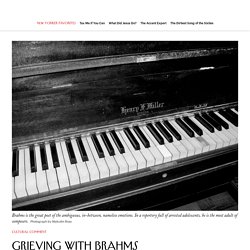
I identify with the protagonist of Wallace Stevens’s “Anglais Mort à Florence,” for whom Brahms is a “dark familiar.” People who claim to find Brahms dry or dismal—it’s not an uncommon opinion, even among otherwise discerning music lovers—are speaking gibberish that I can’t debate, because I don’t understand a word. I find him the most companionable, the most sympathetic of composers. There is enormous sadness in his work, and yet it is a sadness that glows with understanding, that eases gloom by sharing its own. The music seems in a strange way to be listening to you, even as you listen to it. Watch Animated Scores of Beethoven's 16 String Quartets: An Early Celebration of the 250th Anniversary of His Birth. Two years ago we posted about a music lover’s life’s work--Stephen Malinowski aka smalin on YouTube--and how he has produced animated, side-scrolling scores to classical music.

Older folks will liken them to neon piano rolls. Youngun’s will see a bit of Guitar Hero or Rock Band game design in their march of colorful shapes dancing to everything from Bach to Debussy. Malinowski let us know that he just recently completed a major work: adapting all of Beethoven’s String Quartets into his particular, always evolving style. And for this he turned to New York’s Alexander String Quartet for their recordings.
Says the animator: I made my first graphical scores in the 1970s, my first animated graphical score in 1985, and the first of these for a movement of a Beethoven string quartet in 2010. One important point: Malinowski does not choose colors randomly or because they are pretty. This might not make sense just by reading it, but head to this page to see how the color wheel looks. Symphony No. 4 (Brahms) The symphony is divided into four movements with the following tempo markings: Allegro non troppo (E minor)Andante moderato (E minor – E major)Allegro giocoso (C major)Allegro energico e passionato (E minor) This is the only one of Brahms' four symphonies to end in a minor key.
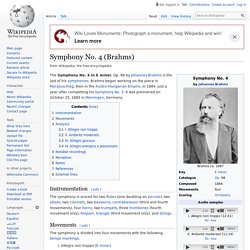
A typical performance lasts about 40 minutes. The opening theme is initially serene in character, although its composition in a chain of descending thirds adds a fateful air. Its left-versus-right fragmented melodic form (duh-DUM, da-DEE, duh-DUM, da-DEE) also introduces a feeling of conflict which Brahms uses as a fundamental motivation throughout the movement. Featuring a theme in the Hypophrygian mode, heard at the beginning unaccompanied and at the end with a lush orchestral accompaniment, this movement has a modified sonata form with no development section. This movement is the only one with the character of a scherzo to be found in Brahms' symphonies. Walter Frisch. Daniel Barenboim conducts Beethoven's 3rd Symphony in E flat major, 'Eroica'
First Listen: Henryk Górecki, Symphony No. 4, 'Tansman Episodes' Henryk Górecki's Symphony No. 4 will be released on Jan. 22.
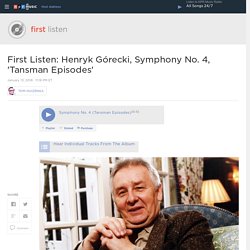
Jean Guyaux/Courtesy of Electra Nonesuch/Boosey & Hawkes Collection hide caption toggle caption Jean Guyaux/Courtesy of Electra Nonesuch/Boosey & Hawkes Collection Henryk Górecki's Symphony No. 4 will be released on Jan. 22. Jean Guyaux/Courtesy of Electra Nonesuch/Boosey & Hawkes Collection Remember Polish composer Henryk Górecki's Third Symphony, the one called "Symphony of Sorrowful Songs? " Now, nearly 25 years after that mainstream success, comes the first recording of Górecki's symphonic follow-up. Górecki left the work incomplete when he died in 2010, yet fully written out in a piano score with instructions for some of the orchestration.
Górecki's bleak 5-note opening theme is punctuated by a trio of booming bass drums. They roll over into the opening moments of the comparatively subdued second movement. "What you give, write it down in sand," he said. Mozart's Violin Comes To Boston, Live In Concert. Playing Mozart — On Mozart's Violin : Deceptive Cadence. Hide captionViolinist Amandine Beyer holds Mozart's own violin backstage at Boston's Jordan Hall on Monday.
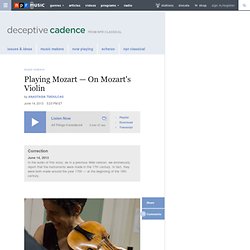
Kathy Wittman/Courtesy of the Boston Early Music Festival Violinist Amandine Beyer holds Mozart's own violin backstage at Boston's Jordan Hall on Monday. The violin and viola that Wolfgang Amadeus Mozart played himself are in the United States for the first time ever. The instruments come out of storage only about once a year at the Salzburg Mozarteum in Austria. The rest of the time, they're kept under serious lockup. I could feel my heart stop. For safety's sake, the violin and viola were flown here on separate airplanes. "Our main thing is to travel so unspectacular as possible, that nobody should know what is inside the cases," says Gabriele Ramsauer, the director of the Mozart Museums. They were made in the early 17th 18th century as workhorse fiddles — sturdy and plain, and meant as tools.
The Orchestra: The best classical music iPad app from Esa-Pekka Salonen. Screenshot via The Orchestra.
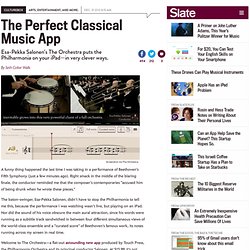
A funny thing happened the last time I was taking in a performance of Beethoven’s Fifth Symphony (just a few minutes ago). Right smack in the middle of the blaring finale, the conductor reminded me that the composer’s contemporaries “accused him of being drunk when he wrote these pieces.” MOZART= concerto pour cor - Dennis Brain. Jascha Heifetz - Bach, Chaconne From Partita No.2 In D Minor, BWV 1004. Jascha Heifetz plays Paganini Caprice No. 24.